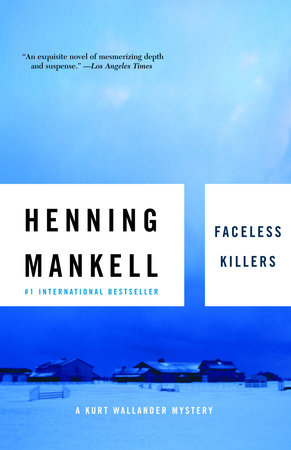Faceless Killers Reader’s Guide
By Henning Mankell


1. In what ways is Faceless Killers surprising? What is unusual about its crimes and the manner in which they are solved? Why would Henning Mankell choose to make the novel about two apparently disconnected crimes, one motivated by greed and another by racial hatred? How do you think the refugees are portrayed? And why?
2. Rydberg describes the crime scene as being so grisly it was “like an American movie” [p. 21]. What does this comment suggest about the relationship between representations of violence for purposes of entertainment and real violence? What does it suggest about the differences between Sweden and America?
3. In what ways do the setting, an isolated area of rural Sweden, and the story’s first victims, an elderly couple, make the murders seem especially horrifying?
4. Before a press conference, Wallander has an attack of self-doubt. “I’m searching for the slayers of the dead,” he says, “and can’t even pay attention to the living” [p. 97]. What aspects of his life is he neglecting? Why does Henning Mankell devote so much of the novel to Wallander’s personal life: his strained relationships with his father, his daughter, and his soon to be ex-wife? What does this personal dimension add to the novel?
5. Wallander wonders why “almost every policeman was divorced. Why their wives left them. Sometimes, when he read a crime novel, he discovered with a sigh things were just as bad in fiction. Policemen were divorced. That’s all there was to it” [p. 27]. What is it about being a cop that would make marriage unsustainable? How does Wallander feel about his estranged wife? What do their interactions reveal about why the marriage failed?
6. Within moments of meeting Ellen Magnusson, Wallander suddenly realizes that she is “the mystery woman with whom Johannes Lövgren had had a child. Wallander knew it without knowing how he knew” [p. 248]. To what extent is this kind of intuition responsible for solving crimes in Faceless Killers? Where else does a hunch or sudden insight play a role in leading the detectives in the right direction? How does it help him solve the murder of the Somali refugee?
7. Confronted by a case he cannot solve, Wallander is plunged into an existential crisis: “Somewhere in the dark a vast meaninglessness was beckoning. A sneering face that laughed scornfully at every attempt he made to manage his life” [p. 80]. In what way is Faceless Killers, and perhaps every mystery novel, about the need to assign meaning to a world that can appear random, chaotic, and meaningless? How does solving a crime restore, if only briefly, order to the world?
8. Much of Faceless Killers is concerned with the controversies surrounding refugees, asylum-seekers, and open borders in Sweden. What is Wallander’s attitude toward these issues? What does the novel, as a whole, seem to suggest about the tensions between Sweden’s liberal immigration policies and its growing racial tensions? How do Wallander’s erotic dreams about a black woman, and his daughter’s relationship with a black man, fit into this context?
9. What specifics does the novel reveal about how police investigations are conducted? About the strained relations between the police, the press, and the government? About the connection between sudden insight and the dogged search for clues?
10. How important is Wallander’s relationship with Rydberg? What does Rydberg add both to the investigation and to the novel?
11. Wallander finds himself frequently knocked to the ground during the course of his investigations, nearly loses his job, gets slapped in the face, and refers to himself as both a “dubious cop” and a “pathetic cop.” When a fellow officer calls him “the hero of the day,” Wallander replies: “Piss off” [p. 107]. Is Wallander a hero? If so, how do his flaws and foibles fit into his heroism?
12. Looking back over the investigation with Rydberg, Wallander says, “I made a lot of mistakes,” to which his partner replies, “You’re a good policeman. . . . You never gave up. You wanted to catch whoever committed those murders in Lunnarp. That’s the important thing” [p. 279]. What were Wallander’s mistakes? Why did he make them? Is Rydberg right in suggesting that perseverance and will are more important than perfect police work?
13. At the very end of Faceless Killers, as Kurt Wallander reflects on the “senseless violence” he has seen, he thinks about “the new era, which demanded a different kind of policeman. We’re living in the age of the noose. . . . Fear will be on the rise” [p. 280]. What does Wallander mean by “the age of the noose”? What changes and new fears does he envision? Have these fears been validated by the events of the decade since the book was first published?
14. Most Americans have a rather idyllic view of life in Sweden. In what ways does Faceless Killers contradict that view? Is it disconcerting to learn that Sweden suffers many of the same problems—drugs, crime, racism—that beset the United States?
Just for joining you’ll get personalized recommendations on your dashboard daily and features only for members.
Find Out More Join Now Sign In